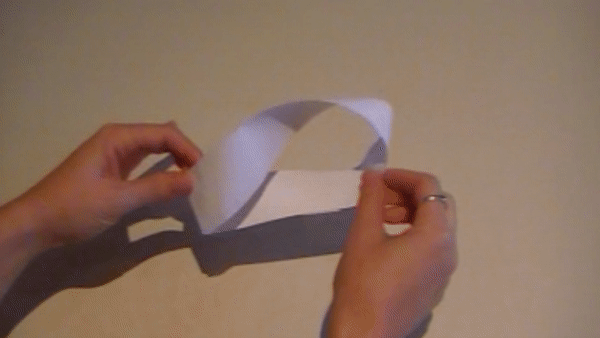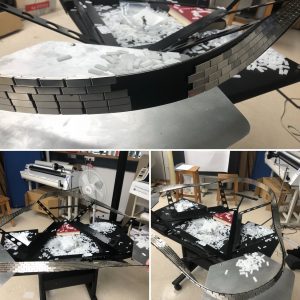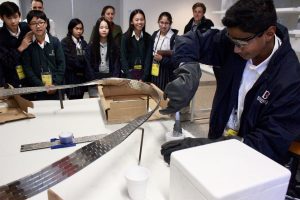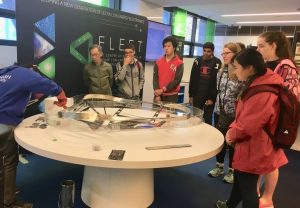A super-cooled, superconducting Mobius-track impresses the crowds, helps embed FLEET science
As a cool science demo, FLEET’s superconductor Mobius track ticks all the boxes: liquid nitrogen – tick. Superconductor – tick. Cool shape – tick. Relevance to the science – tick tick tick.
The track features 1500 neodymium magnets, fixed into the shape of a Mobius strip, so that a small superconducting ‘puck’, when cooled in liquid nitrogen, will whizz around the track, spending half of each orbit hanging suspended by its ‘pinned’ internal magnetic fields.
The superconducting Mobius track allows FLEET to demonstrate a bunch of relevant science concepts, including:
- topology (via the Mobius strip)
- superconductivity (an interesting quantum state with implications for electric current)
- magnetism
- low-temperature physics.
And it’s also really fun! And that’s key. Physical science demonstrations that make a real impact on the viewer have a clear advantage in embedding the knowledge learned. The Mobius track and associated liquid nitrogen have been a highlight of lab tours – no matter the age group, from school students to visiting scientists.
The track aids in the challenge of demonstrating invisible, atomic-scale science, by providing a physical demonstration.
Want to build your own track? Mobius track chief engineer Dr Dianne Ruka (also FLEET’s outreach coordinator) is happy to share construction details. See contact details below.
The science
 The Mobius strip is perhaps the most famous of topological shapes – a simple but fascinating demonstration of this interesting branch of mathematics. Easily constructed from a simple strip of paper twisted once before being rejoined, the Mobius strip is variously described as a piece of paper with only one side, or a 2D object in 3D space. The importance of topological materials at FLEET is further reflected by the Mobius strip that forms the Centre’s logo.
The Mobius strip is perhaps the most famous of topological shapes – a simple but fascinating demonstration of this interesting branch of mathematics. Easily constructed from a simple strip of paper twisted once before being rejoined, the Mobius strip is variously described as a piece of paper with only one side, or a 2D object in 3D space. The importance of topological materials at FLEET is further reflected by the Mobius strip that forms the Centre’s logo.
Superconductivity is a quantum state where electric current can flow without resistance, and a useful introduction to other quantum states investigated within FLEET. Eg, zero-viscosity superfluids, which flow without losing energy, and are studied for their potential in ultra-low energy, zero-dissipation electronics. When cooled, the ultra-low-resistance superconductor ‘puck’ maintains remarkably long-lived surface currents whose magnetic fields fix the puck in place.
Low-temperature physics is a feature of FLEET experimentation, whether in ultra-cold, laser-cooled atomic gases (only a few billionths of a degree above absolute zero), or in equipment such as scanning tunneling microscopes, which may operate at 63K (liquid nitrogen) or 4K (liquid helium) for better image resolution.
Magnetism in several forms is studied at FLEET for its potential to control electron spin in future spintronic devices.
Kudos to the design and construction team

Under construction: John Monash work experience student creating Mobius strip track 2.0. (fingers sore from prying those magnets apart!)
FLEET’s first, prototype Mobius track was constructed by Monash undergraduate students Cameron Smith and Seth Anandam as part of a summer project, and featured custom 3D-printed cups for the magnets. The students took on the task of developing hands-on games and resources to demonstrate FLEET-relevant science themes in the classroom.
Subsequent models have been built at Monash Instrumentation Facility.
Outreach at FLEET
The Mobius track has been used to engage a range of visitors, from year 8 schoolkids visiting FLEET’s labs as part of the Centre’s collaboration with Monash Tech School, to prospective physics undergrads at university open days, to senior science policy-makers with the Australian Research Council.
FLEET, a collaboration of researchers across seven Australian universities, takes seriously its shared responsibility to engage Australians with science.
The Centre is developing innovative ways to connect school students with physics, and to effectively communicate some of the science studied within the Centre, including relatively new fields of physics.
More information
- Dr Dianne Ruka FLEET Senior Education & Training Coordinator education@fleet.org.au
- Read about outreach at FLEET





